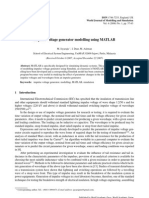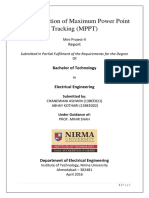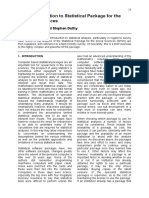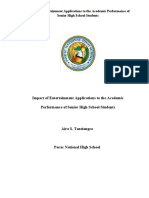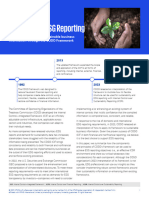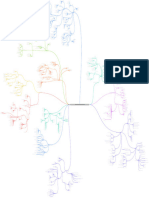Rectifier
Rectifier
Uploaded by
tearamisueCopyright:
Available Formats
Rectifier
Rectifier
Uploaded by
tearamisueCopyright
Available Formats
Share this document
Did you find this document useful?
Is this content inappropriate?
Copyright:
Available Formats
Rectifier
Rectifier
Uploaded by
tearamisueCopyright:
Available Formats
> IEEE Technology and Engineering Education (ITEE)
VOL. 7, NO.4 December, 2012< 62
MATLAB Simulation Techniques in Power Electronics
First A. Hemant Mehar
Abstract The use of simulation has always been a powerful tool for technology in all its various fields of application. Power Electronics course is essential for electrical engineers and is included in the undergraduate-level syllabus. This paper describes a method & concepts used to simulate power electronic circuits using the SIMULINK toolbox within MATLAB software. This paper is also help to student for finding how to choose the parameters values for finding desire results. This paper will discuss the basics of Power Electronics, specifications & simulation. Index Terms power electronics, MATLAB, SIMULINK, simulation
I. INTRODUCTION
ower electronics technology encompasses the use of electronic components, the application of circuit theory and design techniques, and the development of analytical tools toward efficient electronic conversion, control, and conditioning of electric power. The typical undergraduate syllabus will have topics like: uncontrolled and controlled rectifiers with R, RL loads; choppers; single-phase and 3-phase inverters; AC voltage controllers, etc. [1]. The basic information of MATLAB i.e. what is MATLAB, MATLAB Toolbox & SIMULINK, MATLAB Advantages & its application, is presented in [2]. In this paper the characteristics of SCR, simulation of single phase half wave & full wave controlled & uncontrolled rectifiers are presented on MATLAB software.
From this select the blocks which are used to achieve the modelling as follow: first from SIMULINK from commonly used blocks we choose scope (used for show output waveform), bus selector (used for measure signal for example voltage and current waveform in case of diode or SCR) from sources choose pulse generator (used to providing pulse for GATE of THYRISTOR). In SIMULINK library browser Simpowersystems is first chosen & select powerugi (used to select the supply type i.e. continues or discrete). In Simpowersystems various sub library are present for electrical engineering application. From power electronics choose THYRISTOR, MOSFET, GTO etc. Power electronics devices from electrical sources choose supply i.e. AC /DC voltage supply. Then from elements choose RLC series branch for R, L, C, RL, RC or RLC load. Then from measurement choose current & voltage measurement. All the blocks listed above are used in this paper for simulation purpose. By right click we can change the property of blocks. Fig. 1 show the all blocks listed above.
II. MATLAB/SIMULINK FOR POWER ELECTRONICS
The following section will looks at how the modelling and simulation of a power electronic converter can be carried out using MATLAB/SIMULINK software. Firstly open MATLAB then SIMULINK. A SIMULINK library browser will open.
Manuscript received March 28, 2012. This work was supported in under graduate course to learn the working concepts of power semiconductor devices. F. A. Author is with the Electrical & Electronics Engineering Department, Laxmi Narayan Institute of Technology, Indore, MP INDIA, (e-mail: meharhemant@yahoo.com). Publisher Identification Number 1558-7908-2012-30
Fig. 1 Simulation Blocks
1558-7908 201X IEEE Education Society Students Activities Committee (EdSocSAC)
http://www.ieee.org/edsocsac
> IEEE Technology and Engineering Education (ITEE) III. SIMULATION IN POWER ELECTRONICS
VOL. 7, NO.4 December, 2012< 63 B. Uncontrolled half wave rectifier with RL load For this simulation time 0.1 sec; L 0.012 H; R 1ohm; Vsupply sqrt(2)*230
A. Characteristics of SCR Pulse generator setting Amplitude 5; period 0.01 sec; pulse width 50% of period; pulse delay 0.0005 sec, Vdc = 10V; R = 5ohm, Simulation time 0.1 sec
Fig. 3A Simulation Model for Uncontrolled halfwave Rectifier with RL load
Fig.2A Simulation Model for Characteristics of SCR
Fig. 3B Waveforms for Uncontrolled halfwave Rectifier with RL load C. Uncontrolled half wave rectifier with RL load & Freewheeling Diode
Fig. 4A Simulation Model for Uncontrolled halfwave Rectifier with RL load & Freewheeling Diode Fig. 2B Waveforms for SCR Characteristics 1558-7908 201X IEEE Education Society Students Activities Committee (EdSocSAC)
http://www.ieee.org/edsocsac
> IEEE Technology and Engineering Education (ITEE)
VOL. 7, NO.4 December, 2012< 64 E. Controlled Half wave Rectifier with RL Load & Freewheeling Diode
Fig. 4B Waveforms for Uncontrolled halfwave Rectifier with RL load & Freewheeling Diode D. Controlled half wave Rectifier with RL Load
Fig. 6A Simulation Model for Controlled Half wave Rectifier with RL Load & Freewheeling Diode
Fig. 5A Simulation Model for Controlled Half wave Rectifier with RL Load
Fig. 6B Waveforms for Controlled Half wave Rectifier with RL Load & Freewheeling Diode F. Uncontrolled Full wave rectifier with R Load
Fig. 5B Waveforms for Controlled Half wave Rectifier with RL Load
Fig. 7A Simulation Model for Uncontrolled full wave Rectifier with R load
1558-7908 201X IEEE Education Society Students Activities Committee (EdSocSAC)
http://www.ieee.org/edsocsac
> IEEE Technology and Engineering Education (ITEE)
VOL. 7, NO.4 December, 2012< 65 III. CONCLUSION The following conclusion may be derived when using SIMULINK in teaching power electronics courses: As power electronic systems are getting more complex today, the simulation used for education is requiring more features. Some directions in the development of simulation are discussed in this paper, with the help of present model students can simulate the power electronics circuit with various load & conditions. REFERENCES
[1] Abdulatif A. M. Shaban, A Matlab / Simulink Based Tool for Power Electronic Circuits, World Academy of Science, Engineering and Technology, vol. 49, 2009, pp. 274279. Hazim H. Tahir, Teresa Fernndez Pareja, MATLAB Package and Science Subjects for Undergraduate Studies , International Journal for Cross-Disciplinary Subjects in Education (IJCDSE), Volume 1, Issue 1, March 2010. Prof. Sabyasachi Sengupta and et.all, NPTEL Power Electronics Notes [Online]. Available: nptel.iitm.ac.in Chung Kuo, Jack Hsieh, Firuz Zare, Senior Member IEEE, Gerard Ledwich, Senior Member IEEE An Interactive Educational Learning Tool for Power Electronics Conf. Power Engineering, 2007Australasian Universities, AUPEC 2007. P.J. van Duijsen; P.Bauer; B. Davat; Simulation and Animation of Power Electronics and Drives, Requirements for Education [Online]. Available: www.simulation-research.com Sameer Khader The Application of PSIM & MATLAB/SIMULINK in power electronics courses, Conf. "Learning Environments and Ecosystems in Engineering Education" ; IEEE Global Engineering Education Conference (EDUCON) April 4 - 6, 2010, Amman, Jordan
[2]
Fig. 7B Waveforms for Uncontrolled full wave Rectifier with R load G. Uncontrolled Full wave Rectifier with RL Load
[3] [4]
[5]
[6]
Fig. 8A Simulation Model for Uncontrolled full wave Rectifier with RL load
First A. Author received the B.E. degree in Electrical Engg. in 2007 from GEC, Ujjain, India(MP). He has done his M.E. in Power Electronics in 2011 from SGSITS, Indore India(MP). He is working as Assistant Prof, Electrical & Electronics Dept, in Laxmi Narayan College of Technology, Indore, India(MP).
Fig. 8B Waveforms for Uncontrolled full wave Rectifier with RL load
1558-7908 201X IEEE Education Society Students Activities Committee (EdSocSAC)
http://www.ieee.org/edsocsac
You might also like
- Smart Power Processing For Energy Saving: Lab-808: Power Electronic Systems & Chips Lab., NCTU, TaiwanNo ratings yetSmart Power Processing For Energy Saving: Lab-808: Power Electronic Systems & Chips Lab., NCTU, Taiwan21 pages
- Impulse Voltage Generator Modelling Using MATLAB PDFNo ratings yetImpulse Voltage Generator Modelling Using MATLAB PDF8 pages
- An Interactive Educational Learning Tool For PowerNo ratings yetAn Interactive Educational Learning Tool For Power8 pages
- Simulation Model of Single Phase PWM Inverter by Using MATLAB/SimulinkNo ratings yetSimulation Model of Single Phase PWM Inverter by Using MATLAB/Simulink5 pages
- Simulation Model of Single Phase PWM Inverter by Using MatlabNo ratings yetSimulation Model of Single Phase PWM Inverter by Using Matlab6 pages
- Sergi Mansilla - Reactive Programming With RXJS - Untangle Your Asynchronous JavaScript Code (2015, Pragmatic Bookshelf)No ratings yetSergi Mansilla - Reactive Programming With RXJS - Untangle Your Asynchronous JavaScript Code (2015, Pragmatic Bookshelf)8 pages
- A Web-Based Virtual Power Electronics LaboratoryNo ratings yetA Web-Based Virtual Power Electronics Laboratory8 pages
- Tabla de Informacion Sobre Motores ElectricosNo ratings yetTabla de Informacion Sobre Motores Electricos8 pages
- Smart Control of Power Electronic Converters in Photovoltaic Systems PDFNo ratings yetSmart Control of Power Electronic Converters in Photovoltaic Systems PDF17 pages
- A Matlab / Simulink Based Tool For Power Electronic CircuitsNo ratings yetA Matlab / Simulink Based Tool For Power Electronic Circuits6 pages
- Electrical Modeling and Simulation of Industrial Power System With Matlab/Simulink ProgramNo ratings yetElectrical Modeling and Simulation of Industrial Power System With Matlab/Simulink Program7 pages
- Rajiv Gandhi University of Knowledge Technologies - APNo ratings yetRajiv Gandhi University of Knowledge Technologies - AP5 pages
- Impulse Voltage Generation Using MATLAB/Simulink and Its Integration in Undergraduate High Voltage Engineering CourseNo ratings yetImpulse Voltage Generation Using MATLAB/Simulink and Its Integration in Undergraduate High Voltage Engineering Course6 pages
- EContent 7 2024 09 29 15 38 36 01EE1101 BEEEpdf 2023 10 12 09 58 15No ratings yetEContent 7 2024 09 29 15 38 36 01EE1101 BEEEpdf 2023 10 12 09 58 154 pages
- Simulation of 8/6 and 8/14 Switched Reluctance Motor Based On Matlab/Simulink EnvironmentNo ratings yetSimulation of 8/6 and 8/14 Switched Reluctance Motor Based On Matlab/Simulink Environment5 pages
- ISSN 2277 3916 CVR Journal of Science and Technology, Volume 8, June 2015No ratings yetISSN 2277 3916 CVR Journal of Science and Technology, Volume 8, June 20156 pages
- Implementation of Fuzzy Logic Maximum Power Point Tracking Controller For Photovoltaic SystemNo ratings yetImplementation of Fuzzy Logic Maximum Power Point Tracking Controller For Photovoltaic System10 pages
- Guidelines For Modeling Power Electronics in Electric Power Engineering Applications PDFNo ratings yetGuidelines For Modeling Power Electronics in Electric Power Engineering Applications PDF10 pages
- On Modeling Depths of Power Electronic Circuits for Real-Time Simulation a Comparative Analysis for Power SystemsNo ratings yetOn Modeling Depths of Power Electronic Circuits for Real-Time Simulation a Comparative Analysis for Power Systems12 pages
- Simulation of Impulse Voltagemulink Generator and Impulse Testing of Insulator SimulinkNo ratings yetSimulation of Impulse Voltagemulink Generator and Impulse Testing of Insulator Simulink8 pages
- Research Paper On "Study of Technical Parameters On Grid Connected PV System"No ratings yetResearch Paper On "Study of Technical Parameters On Grid Connected PV System"7 pages
- Anupam Er Deoyar Kotha o Dile or Tao Ekahne DhukbeNo ratings yetAnupam Er Deoyar Kotha o Dile or Tao Ekahne Dhukbe3 pages
- Implementation of Maximum Power Point Tracking (MPPT)No ratings yetImplementation of Maximum Power Point Tracking (MPPT)44 pages
- Ijesrt: Square Wave Generator Circuit Analysis Using Matlab ApproachNo ratings yetIjesrt: Square Wave Generator Circuit Analysis Using Matlab Approach11 pages
- Development of Electric Vehicle Powertrain: Experimental Implementation and Performance AssessmentNo ratings yetDevelopment of Electric Vehicle Powertrain: Experimental Implementation and Performance Assessment7 pages
- Application of Fuzzy Logic To The Speed Control of DC MotorNo ratings yetApplication of Fuzzy Logic To The Speed Control of DC Motor6 pages
- Practical Power Electronics: Applications, Experiments and AnimationsFrom EverandPractical Power Electronics: Applications, Experiments and AnimationsNo ratings yet
- Power Electronics: Lecture Notes of Power Electronics CourseFrom EverandPower Electronics: Lecture Notes of Power Electronics CourseNo ratings yet
- An Introduction To Statistical Package For The Social SciencesNo ratings yetAn Introduction To Statistical Package For The Social Sciences12 pages
- Impact of Entertainment Applications To The Academic Performance of Senior High School StudentsNo ratings yetImpact of Entertainment Applications To The Academic Performance of Senior High School Students31 pages
- Penugasan Cashier Enrichment Product Knowledge 2No ratings yetPenugasan Cashier Enrichment Product Knowledge 229 pages
- Break Even - Fixed and Variable Expenses Student Worksheet NameNo ratings yetBreak Even - Fixed and Variable Expenses Student Worksheet Name3 pages
- Midmark Ultra-Series Dental Chairs: ModelsNo ratings yetMidmark Ultra-Series Dental Chairs: Models48 pages
- Delay in Adjudication - Pendency in CourtsNo ratings yetDelay in Adjudication - Pendency in Courts5 pages
- Integrated General Transfer 2023 Final Transfer List of Senior ClerkNo ratings yetIntegrated General Transfer 2023 Final Transfer List of Senior Clerk16 pages
- Annual Barangay Youth Investment Program (Abyip) : FOR THE YEAR 20No ratings yetAnnual Barangay Youth Investment Program (Abyip) : FOR THE YEAR 206 pages
- Standard Chartered Bank Career GuidelinesNo ratings yetStandard Chartered Bank Career Guidelines6 pages
- Roofing Fixer: Schedule of Truss MembersNo ratings yetRoofing Fixer: Schedule of Truss Members1 page
- 1.concept of Locus Standi in Relation To Criminal JurisprudenceNo ratings yet1.concept of Locus Standi in Relation To Criminal Jurisprudence31 pages
- Smart Power Processing For Energy Saving: Lab-808: Power Electronic Systems & Chips Lab., NCTU, TaiwanSmart Power Processing For Energy Saving: Lab-808: Power Electronic Systems & Chips Lab., NCTU, Taiwan
- Impulse Voltage Generator Modelling Using MATLAB PDFImpulse Voltage Generator Modelling Using MATLAB PDF
- An Interactive Educational Learning Tool For PowerAn Interactive Educational Learning Tool For Power
- Simulation Model of Single Phase PWM Inverter by Using MATLAB/SimulinkSimulation Model of Single Phase PWM Inverter by Using MATLAB/Simulink
- Simulation Model of Single Phase PWM Inverter by Using MatlabSimulation Model of Single Phase PWM Inverter by Using Matlab
- Sergi Mansilla - Reactive Programming With RXJS - Untangle Your Asynchronous JavaScript Code (2015, Pragmatic Bookshelf)Sergi Mansilla - Reactive Programming With RXJS - Untangle Your Asynchronous JavaScript Code (2015, Pragmatic Bookshelf)
- Smart Control of Power Electronic Converters in Photovoltaic Systems PDFSmart Control of Power Electronic Converters in Photovoltaic Systems PDF
- A Matlab / Simulink Based Tool For Power Electronic CircuitsA Matlab / Simulink Based Tool For Power Electronic Circuits
- Electrical Modeling and Simulation of Industrial Power System With Matlab/Simulink ProgramElectrical Modeling and Simulation of Industrial Power System With Matlab/Simulink Program
- Rajiv Gandhi University of Knowledge Technologies - APRajiv Gandhi University of Knowledge Technologies - AP
- Impulse Voltage Generation Using MATLAB/Simulink and Its Integration in Undergraduate High Voltage Engineering CourseImpulse Voltage Generation Using MATLAB/Simulink and Its Integration in Undergraduate High Voltage Engineering Course
- EContent 7 2024 09 29 15 38 36 01EE1101 BEEEpdf 2023 10 12 09 58 15EContent 7 2024 09 29 15 38 36 01EE1101 BEEEpdf 2023 10 12 09 58 15
- Simulation of 8/6 and 8/14 Switched Reluctance Motor Based On Matlab/Simulink EnvironmentSimulation of 8/6 and 8/14 Switched Reluctance Motor Based On Matlab/Simulink Environment
- ISSN 2277 3916 CVR Journal of Science and Technology, Volume 8, June 2015ISSN 2277 3916 CVR Journal of Science and Technology, Volume 8, June 2015
- Implementation of Fuzzy Logic Maximum Power Point Tracking Controller For Photovoltaic SystemImplementation of Fuzzy Logic Maximum Power Point Tracking Controller For Photovoltaic System
- Guidelines For Modeling Power Electronics in Electric Power Engineering Applications PDFGuidelines For Modeling Power Electronics in Electric Power Engineering Applications PDF
- On Modeling Depths of Power Electronic Circuits for Real-Time Simulation a Comparative Analysis for Power SystemsOn Modeling Depths of Power Electronic Circuits for Real-Time Simulation a Comparative Analysis for Power Systems
- Simulation of Impulse Voltagemulink Generator and Impulse Testing of Insulator SimulinkSimulation of Impulse Voltagemulink Generator and Impulse Testing of Insulator Simulink
- Research Paper On "Study of Technical Parameters On Grid Connected PV System"Research Paper On "Study of Technical Parameters On Grid Connected PV System"
- Anupam Er Deoyar Kotha o Dile or Tao Ekahne DhukbeAnupam Er Deoyar Kotha o Dile or Tao Ekahne Dhukbe
- Implementation of Maximum Power Point Tracking (MPPT)Implementation of Maximum Power Point Tracking (MPPT)
- Ijesrt: Square Wave Generator Circuit Analysis Using Matlab ApproachIjesrt: Square Wave Generator Circuit Analysis Using Matlab Approach
- Development of Electric Vehicle Powertrain: Experimental Implementation and Performance AssessmentDevelopment of Electric Vehicle Powertrain: Experimental Implementation and Performance Assessment
- Application of Fuzzy Logic To The Speed Control of DC MotorApplication of Fuzzy Logic To The Speed Control of DC Motor
- Computer Methods in Power Systems Analysis with MATLABFrom EverandComputer Methods in Power Systems Analysis with MATLAB
- Analog Dialogue, Volume 47, Number 1: Analog Dialogue, #9From EverandAnalog Dialogue, Volume 47, Number 1: Analog Dialogue, #9
- Practical Power Electronics: Applications, Experiments and AnimationsFrom EverandPractical Power Electronics: Applications, Experiments and Animations
- Power Electronics: Lecture Notes of Power Electronics CourseFrom EverandPower Electronics: Lecture Notes of Power Electronics Course
- An Introduction To Statistical Package For The Social SciencesAn Introduction To Statistical Package For The Social Sciences
- Impact of Entertainment Applications To The Academic Performance of Senior High School StudentsImpact of Entertainment Applications To The Academic Performance of Senior High School Students
- Break Even - Fixed and Variable Expenses Student Worksheet NameBreak Even - Fixed and Variable Expenses Student Worksheet Name
- Integrated General Transfer 2023 Final Transfer List of Senior ClerkIntegrated General Transfer 2023 Final Transfer List of Senior Clerk
- Annual Barangay Youth Investment Program (Abyip) : FOR THE YEAR 20Annual Barangay Youth Investment Program (Abyip) : FOR THE YEAR 20
- 1.concept of Locus Standi in Relation To Criminal Jurisprudence1.concept of Locus Standi in Relation To Criminal Jurisprudence



























